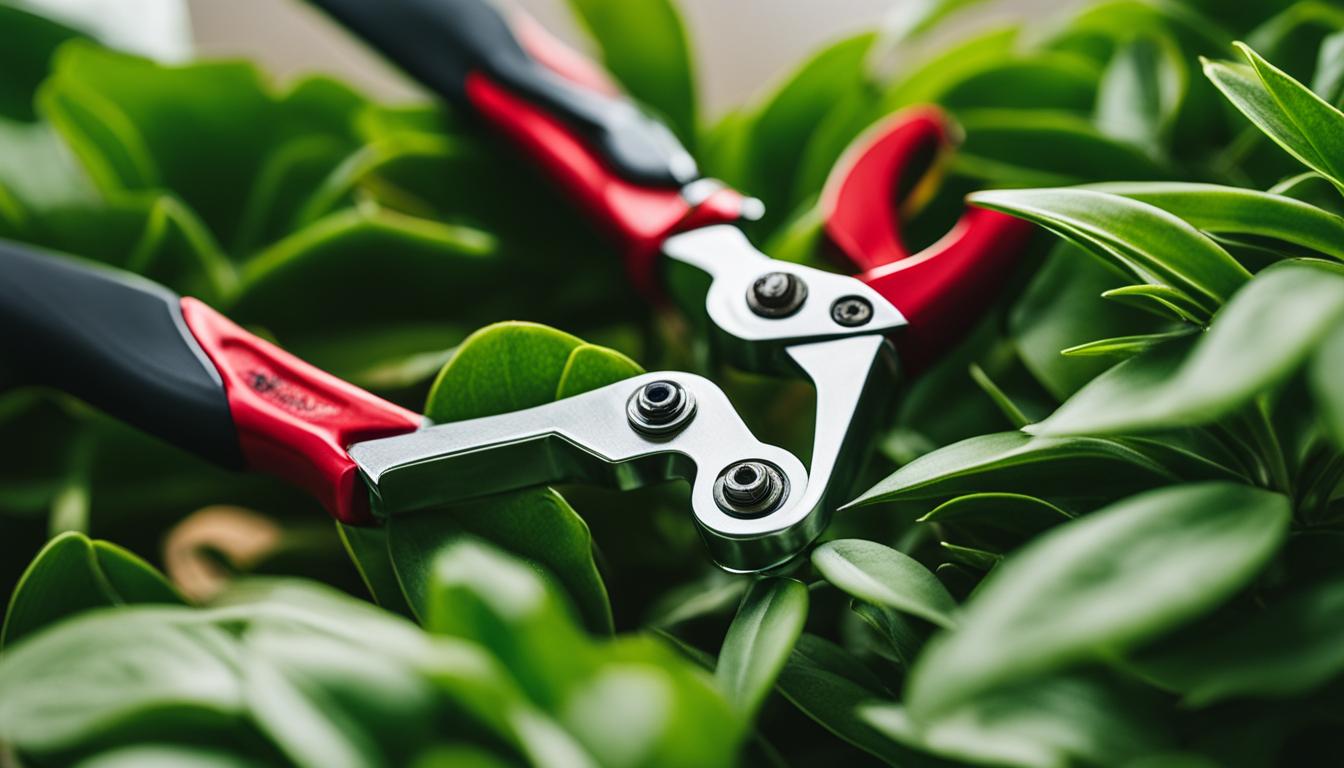
Pruning indoor plants is an essential part of their care and maintenance. It not only keeps them healthy but also encourages new growth and enhances their overall appearance.
To ensure you are using proper pruning methods for indoor plants, it’s important to understand the techniques that yield the best results.
Key Takeaways:
- Pruning indoor plants is crucial for their health and vitality.
- Effective pruning techniques promote new growth and enhance the overall appearance of indoor plants.
- Proper pruning methods help to shape plants, correct structural issues, and reduce the risk of pests and diseases.
- Timing and tools play a significant role in successful indoor plant pruning.
- Regular pruning maintains a lush and attractive indoor garden.
When is the best time to prune indoor plants?
Pruning indoor plants at the right time is crucial for their overall health and growth. The timing of pruning depends on the type of plant and its specific needs. Here are some guidelines to help you determine the best time to prune your indoor plants:
Flowering Plants:
For flowering indoor plants, it is generally recommended to prune them just after they have finished flowering. This allows the plant to redirect its energy towards new bud formation for the next blooming cycle. Pruning immediately after flowering also ensures that you do not accidentally remove any unopened buds that would have turned into beautiful blooms.
Woody Plants:
Woody indoor plants, such as trees or shrubs, may require year-round pruning to maintain their shape and health. Regular pruning helps remove dead or damaged branches, stimulates new growth, and prevents the plant from becoming too dense or overcrowded. It’s important to remove any dead or diseased branches as soon as you notice them to prevent the spread of infection.
| Type of Plant | Best Pruning Time |
|---|---|
| Flowering Plants | After flowering |
| Woody Plants | Year-round pruning |
While the general rule of thumb is to prune houseplants at the beginning of the growing season, which is usually in late winter or early spring for many varieties, it’s always a good idea to research the specific pruning requirements of each plant species to ensure optimal results.
By understanding the best time to prune your indoor plants, you can promote their growth, maintain their shape, and enhance the overall aesthetic appeal of your indoor garden.
Tools for Pruning Indoor Plants
Having the right tools is essential for effectively pruning indoor plants. The proper equipment not only makes the task easier but also helps to achieve clean and precise cuts, promoting healthy growth and minimizing the risk of damage or disease. Here are some commonly used tools for pruning indoor plants:
Pruning Shears
- Bypass Pruners: These shears have a curved blade that slides past a counter blade, providing a clean cut. They are ideal for trimming small branches and stems.
- Anvil Pruners: These shears have a straight blade that cuts against a flat surface, which can crush plant tissue if not used carefully. They are more suitable for cutting dead branches or woody stems.
Loppers
Loppers are designed for pruning larger branches that may be too thick for regular shears. They have long handles and a bypass or anvil cutting mechanism, allowing for more leverage and control.
Pruning Saw
A pruning saw is useful for cutting through thick or hard branches. It usually has a curved blade with large, sharp teeth for efficient cutting. It is important to choose a pruning saw with a comfortable grip and a blade length appropriate for the size of the branches you will be pruning.
Pruning Snips
Pruning snips, also known as floral snips or bud snips, are handy for delicate pruning tasks, such as removing spent flowers or trimming small foliage. They have short, sharp blades and are designed to make precise and intricate cuts.
Gloves
Wearing gloves while pruning indoor plants helps protect your hands from thorns, splinters, or sharp edges. Choose gloves that fit well, provide dexterity, and offer adequate grip to handle tools safely.
By investing in the right pruning tools, you can ensure that your indoor plant pruning sessions are efficient and successful, promoting the health and beauty of your plants.
Tips for Pruning Indoor Plants: Essential Techniques for Maintaining Healthy Greenery
Pruning indoor plants is a skill that every plant owner should possess. It not only helps keep your plants healthy and vibrant but also enhances their overall appearance. To ensure that you prune your indoor plants effectively, here are some essential techniques to follow:
1. Assess the Plant
Before you start pruning, take a good look at your indoor plant and identify any dead, damaged, or diseased branches. These branches should be your priority for removal as they can hinder the plant’s growth and become a breeding ground for pests and diseases. Additionally, keep an eye out for any crossing branches that may rub against each other, as they can cause wounds and create entry points for pathogens.
2. Choose the Right Tools
Having the right pruning tools is crucial for a successful pruning session. Invest in a pair of high-quality pruning shears that can easily cut through small to medium-sized branches. For thicker branches, use loppers or a pruning saw. It’s also important to keep your tools clean and sharp to ensure clean cuts and prevent the spread of diseases.
3. Make Judicious Cuts
When making cuts, always aim to create clean and precise cuts. Avoid leaving stubs, as they can become entry points for pests and diseases. Cut just above a leaf node or bud to encourage new growth in the desired direction. For larger cuts, make a proper pruning cut by following the branch collar. This will help promote quick healing and minimize the risk of infection.
By following these essential pruning techniques, you can maintain healthy and thriving indoor plants that bring beauty and freshness to your living space.
Common Indoor Plants and Their Pruning Needs
| Plant Name | Pruning Needs |
|---|---|
| Ficus elastica (Rubber Plant) | Remove any dead or damaged leaves. Trim leggy growth to maintain a compact shape. |
| Monstera deliciosa (Swiss Cheese Plant) | Prune back overgrown vines and remove any yellowing or browning leaves. |
| Dracaena fragrans (Corn Plant) | Trim long, straggly stems to encourage bushier growth. Remove any dead or yellowing leaves. |
| Sansevieria trifasciata (Snake Plant) | Remove any dead or damaged leaves. Trim excessively tall or leaning growth to maintain an upright form. |
Pruning Vines and Specific Plant Types
When it comes to pruning indoor plants, vines require special attention. These fast-growing plants can quickly become unruly if not properly maintained. Pruning vines is essential to keep them in check and encourage healthy growth. Here are some key tips for pruning vines and specific plant types:
Pruning Vines
Vines, such as pothos, ivy, and philodendron, are known for their trailing nature. To prevent them from overtaking your space, it’s important to prune them regularly. Start by identifying any wandering stems that have strayed from their support structure.
Prune these stems back to the nearest leaf node or supporting branch. This will redirect the plant’s growth and encourage it to fill out along the intended path. You can also trim back any leggy or overly long vines to maintain a more compact shape.
Pruning Specific Plant Types
Each plant type has its own pruning requirements. For example, with flowering plants like roses or orchids, it’s crucial to prune them after they have finished blooming. This allows the plant to direct its energy towards new growth and the development of new buds.
On the other hand, foliage plants like ferns or rubber plants can be pruned throughout the year to remove any yellowing or dead leaves. Trimming back overgrown branches can also help to shape the plants and promote a fuller appearance.
Remember to always use clean, sharp pruning tools when working with indoor plants. This helps prevent the spread of disease and ensures clean cuts that promote healing.
Take the time to understand the specific needs of your plant in terms of pruning, as some species may require more frequent or less aggressive pruning than others. By pruning vines and other specific plant types properly, you can maintain a well-groomed and thriving indoor garden.
| Plant Type | Best Pruning Time | Pruning Technique |
|---|---|---|
| Flowering Plants | After blooming | Remove spent blooms and shape the plant |
| Foliage Plants | Throughout the year | Trim yellowing leaves and shape the plant |
| Vines | As needed | Redirect growth and trim back leggy vines |
Follow these guidelines for pruning vines and specific plant types to ensure your indoor garden remains well-maintained and visually appealing. By staying attentive to their needs and regularly pruning, you can enjoy the benefits of lush, healthy plants that add beauty to your living space.
Benefits of Pruning Indoor Plants
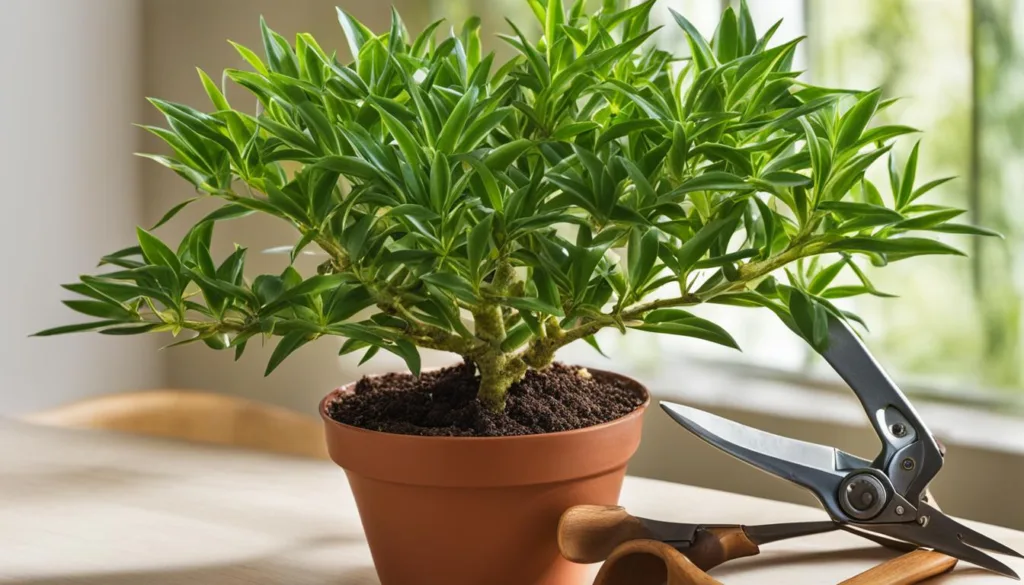
Pruning indoor plants offers a range of benefits that are essential for their overall health and vitality. Proper pruning techniques help maintain the shape and size of the plants, promote new and vigorous growth, and improve their overall appearance.
Also, pruning plays a crucial role in managing pests and diseases, ensuring the longevity of your beloved indoor greenery.
One of the key benefits of pruning indoor plants is that it helps remove dead or damaged foliage, stems, and branches. This eliminates potential entry points for pests and diseases, reducing the risk of infestations and infections.
Pruning also improves air circulation around the plants, preventing the development of fungal issues and promoting better overall plant health.
Furthermore, pruning stimulates the growth of new branches and buds, resulting in a fuller and more lush appearance. By selectively removing certain parts of the plant, you can direct its growth and shape it according to your preferences.
This allows you to create visually appealing arrangements and showcase the unique characteristics of different plant species.
Improved Flowering and Fruit Production
Proper pruning techniques also play a vital role in enhancing flowering and fruit production in certain indoor plants. By removing spent flowers and fruits, you redirect the plant’s energy towards the development of new buds and fruits. This results in a more abundant and vibrant display of blooms and a higher yield of delicious fruits.
Additionally, pruning can help correct structural issues in plants, such as crossing or rubbing branches. By removing these problematic branches, you prevent potential damage and ensure the plant’s long-term growth and stability.
Pruning also encourages the development of strong and well-spaced branches, reducing the risk of breakage and improving the overall structural integrity of the plant.
Key Takeaways from the Benefits of Pruning Indoor Plants
- Pruning indoor plants maintains their shape and size while promoting new growth.
- It eliminates potential entry points for pests and diseases.
- Pruning improves air circulation and overall plant health.
- It stimulates the growth of new branches for a fuller appearance.
- Pruning enhances flowering and fruit production in certain plants.
- It corrects structural issues and improves overall plant stability.
Pruning Considerations and Tips
When it comes to pruning indoor plants, there are a few important considerations to keep in mind. These tips will help ensure that your pruning efforts are successful and beneficial for your plants.
Consider the Plant’s Growth Habit
Each plant has its own unique growth habit, and understanding it is key to proper pruning. Some plants naturally have a bushy or sprawling growth pattern, while others are more upright or vine-like. Take the time to research and understand your specific plant’s growth habit to determine how and where to make your pruning cuts.
Choose the Right Tools
Having the right tools for the job makes a significant difference in the success of your pruning efforts. Sharp and clean tools, such as pruning shears or scissors, ensure clean cuts that heal quickly. Avoid using dull or dirty tools, as they can cause damage to the plant and increase the risk of infection. Before pruning, take a moment to clean and sanitize your tools to prevent the spread of diseases or pests.
Make Judicious Cuts
When pruning indoor plants, it’s important to make judicious cuts to promote healthy growth. Avoid removing more than one-third of the plant’s foliage at a time, as excessive pruning can weaken the plant and hinder its ability to recover. Instead, focus on selectively removing dead or damaged foliage, as well as any crossing or overcrowded branches that may be inhibiting airflow or light penetration.
Maintain Cleanliness
After pruning, it’s essential to clean up any debris or fallen foliage around the plant. This helps prevent the spread of diseases and pests that may have been present on the pruned material. Dispose of the debris properly and consider sanitizing the surrounding area to ensure a clean and healthy environment for your plants.
By considering these tips and following proper pruning techniques, you can effectively maintain the health and appearance of your indoor plants. Keep in mind the unique characteristics of each plant, use the right tools, make selective cuts, and maintain cleanliness to ensure successful pruning.
Recovery and Aftercare After Pruning
After pruning, it’s important to provide proper care and support for your plants as they recover from the pruning process. While plants may initially appear droopy or stressed due to shock, they should bounce back with the right aftercare. Here are some essential steps to help your plants recover and continue to thrive:
- Watering: Ensure that your plants receive adequate hydration after pruning. Monitor the soil moisture levels and water accordingly, allowing the soil to dry slightly between waterings.
- Lighting: Continue to provide the appropriate amount of light for your plants. Most indoor plants require bright, indirect light, while specific species may have different light requirements. Adjust the placement of your plants if needed to ensure they receive optimal light conditions.
- Fertilization: Support your plants’ recovery and growth by providing regular fertilization. Choose a balanced indoor plant fertilizer and follow the recommended dosage instructions. Fertilizing every 4-6 weeks during the growing season can help replenish essential nutrients.
- Monitor for pests and diseases: Pruning can leave plants vulnerable to pests and diseases. Keep a close eye on your plants for any signs of infestation or disease, such as yellowing leaves, spots, or unusual growth. Take immediate action to address any issues to protect the health of your plants.
Remember to be patient with your plants as they recover. It may take a few days or weeks for them to regain their vigor and show signs of new growth. Providing consistent care and attention will help ensure their successful recovery and continued well-being.
| Aftercare Tips: |
|---|
| Monitor soil moisture levels and water accordingly |
| Provide optimal lighting conditions |
| Fertilize regularly during the growing season |
| Keep an eye out for pests and diseases |
Pruning for a Lush Indoor Garden
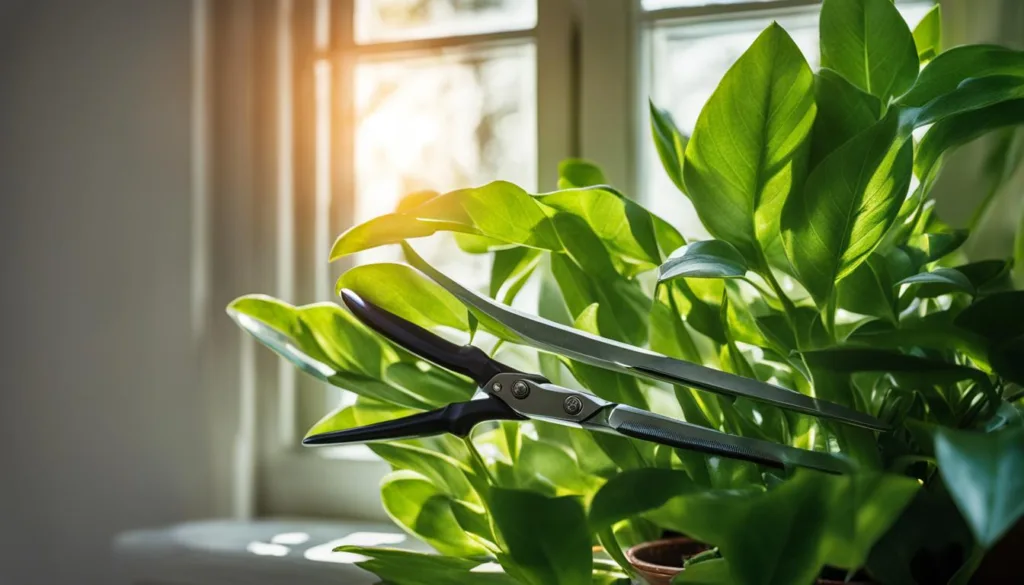
Pruning is an essential practice for maintaining a lush and attractive indoor garden. By carefully shaping and grooming indoor plants, you can create a visually pleasing space and promote healthy growth. Regular pruning not only enhances the overall appearance of your plants but also helps to correct any structural problems they may have.
One of the primary benefits of pruning is that it encourages new growth. By removing dead or damaged leaves, stems, and branches, you stimulate the plant’s natural regenerative processes.
This results in a fuller, more vibrant plant with increased foliage and blooms. In addition, pruning helps to maintain the size and shape of your plants, preventing them from becoming unruly or overgrown.
To effectively prune your indoor plants, start by assessing each plant’s unique needs. Consider its growth habit, size, and desired shape before making any cuts. Use clean and sharp pruning tools, such as pruning shears or scissors, to make precise cuts without causing unnecessary damage.
Remember to make angled cuts just above a leaf node or bud to encourage new growth in the desired direction.
Pruning Dos and Don’ts for Indoor Plants
| Do | Don’t |
|---|---|
| Prune regularly to maintain plant health and appearance. | Prune excessively, as it may weaken the plant. |
| Remove dead or yellowing leaves to improve plant aesthetics. | Remove healthy foliage, as it may disrupt the plant’s overall balance. |
| Make clean cuts just above a leaf node or bud. | Leave stubs or jagged cuts that may invite pests and diseases. |
| Prune after the plant has finished flowering, if applicable. | Prune during the plant’s dormant period, as it may impede growth. |
| Dispose of pruned plant material properly to prevent the spread of pests and diseases. | Leave pruned debris near healthy plants, risking infestation or infection. |
By following proper pruning techniques and taking into account the specific needs of each indoor plant, you can create an enchanting indoor garden that is both visually stunning and healthy. Regular grooming and shaping will not only maintain the desired size and shape of your plants but also promote optimal growth and vitality.
Pruning indoor plants is a vital part of their care and maintenance. By following effective pruning techniques, you can ensure the health, vitality, and aesthetic appeal of your indoor greenery.
To summarize, here are the key points to remember:
- Assess the plant’s needs before pruning, considering its species, growth habits, and overall condition.
- Use the right tools, such as pruning shears, scissors, or pruners, to make clean and precise cuts.
- Make judicious cuts, removing dead, diseased, or damaged parts, as well as crossing branches and excessive growth.
- Maintain cleanliness by disinfecting your tools and removing any debris to prevent the spread of diseases.
By adhering to these practices, you can control the size and shape of your indoor plants, encourage new growth, and enhance the overall appearance of your indoor garden.
Remember, regular pruning not only helps your plants thrive but also reduces the risk of pests and diseases. So, take the time to prune your indoor plants and enjoy the benefits of a lush and vibrant indoor oasis.
FAQ
What are effective indoor plant pruning techniques?
Effective indoor plant pruning techniques include assessing the plant, choosing the right tools, making judicious cuts, and maintaining cleanliness. Pruning helps control the size and shape of plants, promotes new growth, and enhances the overall appearance of your indoor garden.
When is the best time to prune indoor plants?
The best time to prune indoor plants depends on the type of plant. Woody indoor plants may require year-round pruning to remove dead leaves and branches. For flowering species, it is best to prune them just after they have finished flowering. The general rule of thumb is to prune houseplants at the beginning of the growing season, which is usually late winter or early spring for many varieties.
What tools are needed for pruning indoor plants?
Some commonly used tools for pruning indoor plants include pruning shears, scissors, or pruners for small branches or leaves, and a pruning saw or loppers for larger branches. It is important to have the right tools for effective and clean cuts.
How can I prune indoor plants effectively?
To prune indoor plants effectively, follow these steps: assess the plant’s needs, choose the appropriate tools, make cuts at a 45-degree angle just above a leaf node or bud, remove dead or diseased parts, and maintain cleanliness by disinfecting tools between plants.
How should I prune vines and specific plant types?
Pruning vines is similar to pruning general houseplants but may require more substantial pruning in spring or summer to manage their growth. It is important to encourage vines to grow along a support and prune any wandering stems. Different plant types may require specific pruning techniques, so it is essential to research and understand the needs of each plant.
What are the benefits of pruning indoor plants?
Pruning indoor plants offers several benefits, including shaping plants, correcting structural problems, promoting new growth, improving overall plant health, reducing the risk of pests and diseases, and enhancing the appearance of your indoor garden.
What considerations and tips should I keep in mind when pruning indoor plants?
When pruning indoor plants, consider the plant’s growth habits, the amount of foliage to remove, and the desired shape. Avoid excessive pruning that can weaken the plant. It is also important to avoid pruning during periods of active growth or flowering. Lastly, maintain cleanliness by disinfecting tools and removing pruned plant material promptly.
How should I care for plants after pruning?
After pruning, plants may need some time to recover. They may appear droopy for a few days due to shock but should bounce back. To support their recovery and continued growth, ensure regular fertilization and provide appropriate care, such as watering and meeting their specific light requirements.
How does pruning contribute to a lush indoor garden?
Pruning plays a crucial role in maintaining a lush and attractive indoor garden. It helps shape plants, correct structural problems, promote new growth, improve overall plant health, and reduce the risk of pests and diseases. Regular pruning ensures your indoor garden remains vibrant and visually appealing.

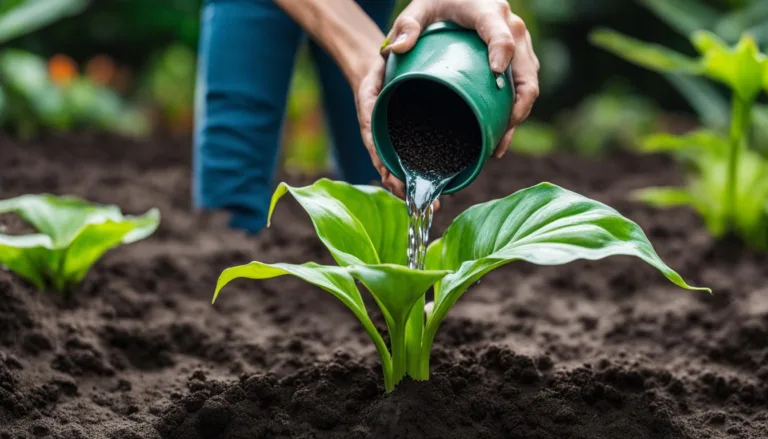
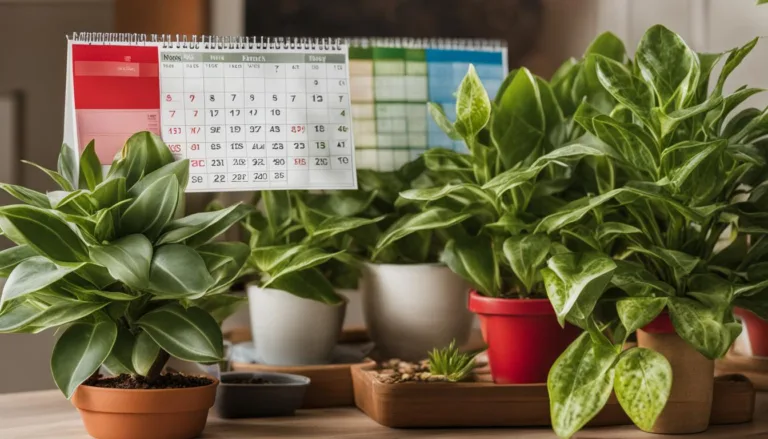

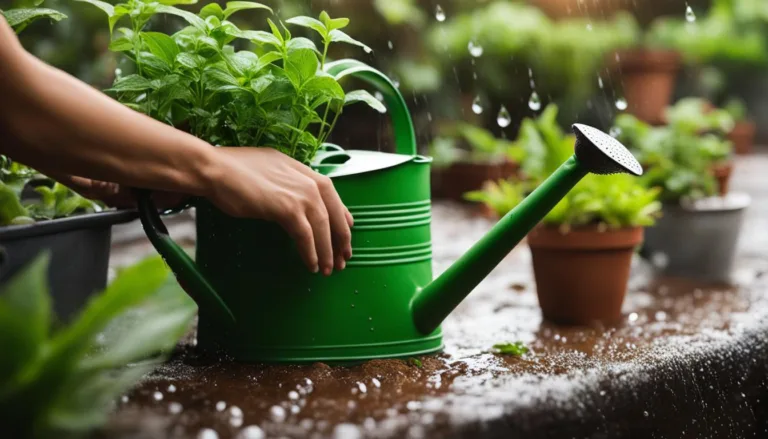
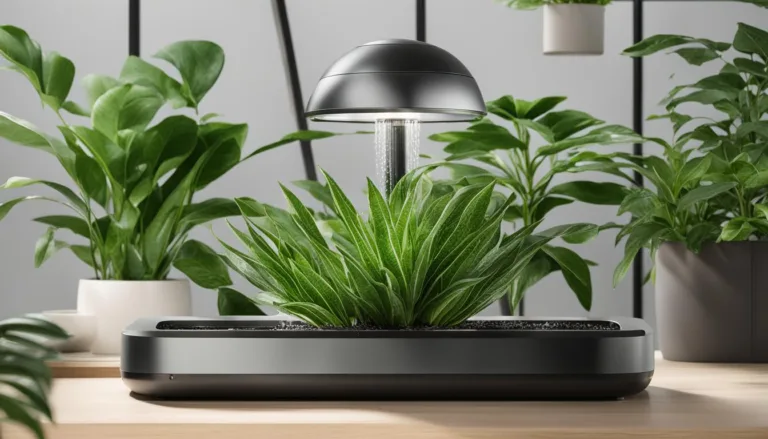

2 Comments
Comments are closed.